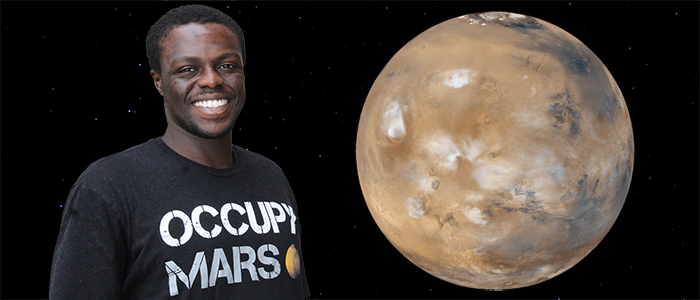Media
Contact
Communications Specialist
Faculty of Engineering
Spencer Engineering Building
Room 2072
Western University
Tel: 519-661-2111 ext. 87015
Email: engineeringcomms@uwo.ca
PhD student Jon Kissi is keeping a sharp eye on the Red Planet

Western Engineering News | May 2, 2017
As a small boy, Jon Kissi, a Western Engineering PhD student, was a self-proclaimed ‘space geek’. A Star Trek fan, a lover of all things science and outer space, he dreamed of a world far beyond his own front door. “I loved everything science,” recalled Kissi. “But, if somebody told me that I’d actually end up working in space exploration, I never would have believed them.”
Flash forward a few decades to the Mars Reconnaissance Orbiter (MRO). This multi-purpose spacecraft was designed to conduct reconnaissance and exploration of Mars from orbit. In 2001, a team of scientists determined that high-resolution images were needed in order to support sample return and surface exploration of Mars. They created a proposal for a specialized high resolution camera. NASA accepted the proposal and the HiRISE camera became a reality. HiRISE, which stands for High Resolution Imaging Science Experiment, can take pictures of Mars with resolutions of 0.3 m/pixel, resolving objects below a meter across. It is designed to view the surface features of Mars in greater detail than has previously been possible.
Enter Professor Livio Tornabene, Adjunct Professor, Department of Earth Sciences at Western and HiRISE Science team member. Since joining Western’s faculty, Tornabene was able to bring the project to Western’s Centre of Planetary Science and Exploration (CPSX). This is the fifth time the science planning of HiRISE images has been lead from Canada.
“It was discussed that it would be a good idea to see if students would want to take part in this experience,” explained Kissi. “There are so many students here who are involved in CPSX, wouldn’t it be great if some of them could get experience on a space mission?”
Kissi jumped at the chance to be involved in the project which brings together students from a variety of disciplines. Kissi is the first Engineering student who has worked on the mission and he couldn't be more thrilled. “My research is in geology and creating systems which use machine learning to help geologists characterize different types of surface rock in real time,” he explained. “When you land on the surface of a planet, what’s the first thing you’re going to encounter? Rocks!”
The HiRISE camera provides detailed views of the surface of Mars which help determine where soil samples are collected and even where space rovers might land. The Western-based team is charged with selecting the observations which will become images based on certain criteria. “It’s not a situation where you get to choose your favourite,” Kissi said. “There’s loads of criteria: is the satellite in the right place? Is the sun in the right place? Is this the right time?”
Once Kissi and the team have made their suggestions, they send them to the Lunar and Planetary Laboratory HiRISE Operations Team at the University of Arizona. From there, the final decision is made and the coordinates and specific commands are sent to the satellite.
“Countless things have surprised me about Mars,” recalled Kissi. “What’s surprised me the most is how active the surface is. It’s literally moving on a daily basis with avalanches, dust and other things. It’s an incredible thing to see.”
With all of Canada watching the Canadian Space Agency right now as they continue their selection process to find the next Canadian Astronaut, the question of whether Kissi would ever want to journey into the great beyond inevitably creeps into the conversation.
“Lots of people say they wouldn't want to be an astronaut because of the danger or whatever,” he explained. “But, I'm not one of those people. If somebody said they wanted me to do it, then I’d just go!”
When he’s not keeping a sharp eye on the surface of Mars, Kissi is a dedicated PhD student in the Department of Electrical and Computer Engineering. “The last three years at Western have been three of the happiest years for me,” he said. “Being here, being able to really expand my mind is really important to me.”
The future is very bright for Kissi as he wraps up this HiRISE mission and continues his studies. “I want a career in space engineering,” he explained. “I started off in journalism, but I was always dreaming about being able to have the knowledge required to build the things I saw in my head.”
For Jon Kissi, that dream is coming true.
To learn more about CPSX click here.
For more information about the HiRISE mission click here.

